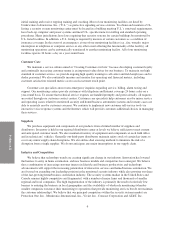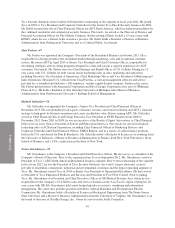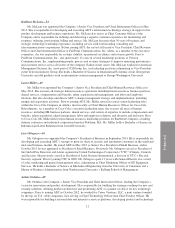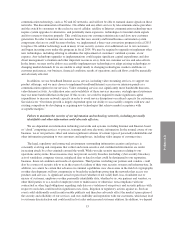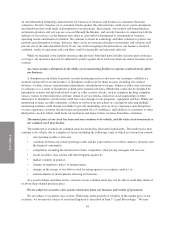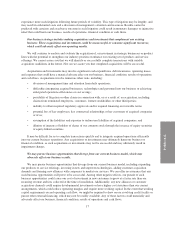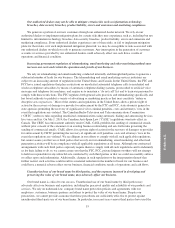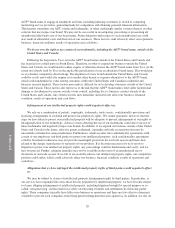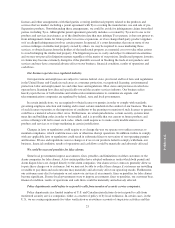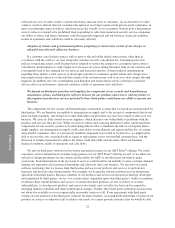ADT 2014 Annual Report Download - page 78
Download and view the complete annual report
Please find page 78 of the 2014 ADT annual report below. You can navigate through the pages in the report by either clicking on the pages listed below, or by using the keyword search tool below to find specific information within the annual report.
FORM 10-K
strategies, and launching new applications and services with key partners including Comcast Cable, NBC-
Universal, Time Warner Cable and Cox Communications. Prior to joining Canoe Ventures, Mr. Orduña was
Senior Vice President of Policy & Product for Advance/Newhouse—Bright House Networks. Earlier in his
career, he served as Vice President of Product & Marketing for Canal+ Technology U.S./Vivendi-Universal, and
also Vice President of Product & Marketing for Integrated Systems Inc./Diab-SDS before its acquisition by Wind
River Systems/Intel. He holds a Bachelor of Arts from Cornell University.
Item 1A. Risk Factors.
In addition to risks and uncertainties in the ordinary course of business that are common to all businesses,
important factors that are specific to our industry and our Company could have a material and adverse impact
on our business, financial condition, results of operations and cash flows. You should carefully consider the risks
described below and in our subsequent periodic filings with the SEC. The following risk factors should be read in
conjunction with “Management’s Discussion and Analysis of Financial Condition and Results of Operations”
and the consolidated and combined financial statements and related notes in this report.
Risks Relating to Our Business
We sell our products and services in highly competitive markets, including the home automation market,
which may result in pressure on our profit margins and limit our ability to maintain or increase the
market share of our products and services. We may not be able to continue to develop and execute a
competitive yet profitable pricing structure.
The monitored security industry is highly fragmented and subject to significant competition and pricing
pressures. We experience significant competitive pricing pressures on installation, monitoring and service fees.
Several significant competitors offer installation fees that match or are lower than ours. Other competitors charge
significantly more for installation but, in many cases, less for monitoring. In addition, cable and
telecommunications companies are expanding into the monitored security industry and are bundling their
existing offerings with monitored security services. In some instances, it appears that the monitored security
services component of such bundled offerings is significantly underpriced and, in effect, subsidized by the rates
charged for the other services offered by these companies. These pricing alternatives may influence customers’
desire to subscribe to our services at rates and fees we consider appropriate. In many cases, we face competition
for direct sales from our authorized dealers, who may offer installation for considerably less than we do in
particular markets. We believe that the monitoring and service fees we offer are generally competitive with rates
offered by other security service providers. We face competition from other providers such as cable and
telecommunications companies that may have greater capital and resources than us, and may benefit from
superior advertising, marketing and promotional resources which could have a material adverse effect on our
ability to drive awareness and demand for our products and services. We also face potential competition from
improvements in Do-It-Yourself (DIY) or self-monitoring systems which enable customers to monitor and
control their environments without third-party involvement through the Internet, text messages, emails or similar
communications, but with the disadvantage that alarm events may go unnoticed. It is possible that one or more of
our competitors could develop a significant technological advantage over us that allows them to provide
additional service or better quality service or to lower their price, which could put us at a competitive
disadvantage. Continued pricing pressure or improvements in technology and shifts in customer preferences
towards self-monitoring or DIY could adversely impact our customer base and/or pricing structure and have a
material adverse effect on our business, financial condition, results of operations and cash flows.
We resist competing on price alone because we believe we have competitive advantage such as brand name
recognition and a reputation for a high level of service and security. However, with cable and
telecommunications companies actively targeting the home automation market and expanding into the monitored
security space, and with large technology companies expanding into the connected home market through the
development of their own solutions or the acquisition of other companies with home automation solution
offerings, this increased competition could result in pricing pressure, a shift in customer preferences towards the
12






